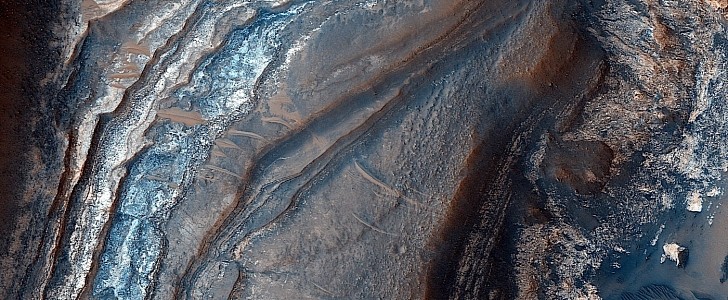For one reason or another, people decided long ago to name all the important places on Mars using Latin words. In fact, the whole planet wears the name of the Roman God of War, so the choice of keeping with tradition might have seemed like a natural one.
Generally, the names given to these alien places are nothing more than descriptors of a given feature, like say valles for valley or mons for mountain. Pretty benign words, generally, but there are times when some of them are brought together to form a frightening phrase.
One such case is Noctis Labyrinthus, which would roughly translate as night’s labyrinth. The moniker was slapped onto a region in the Tharsis area that is famous among people studying Mars for its intricate system of valleys.
Formed sometime in the planet’s past by means of faulting, these valleys are also very deep, and for geologists, that’s godsent, as they can peer into the Martian past by studying the layers of soil, as they’re visible from up in orbit to the HiRISE camera.
The main image of this piece shows a portion of the Noctis Labyrinthus as seen back in 2007 from an altitude of 255 km (158 miles). According to the people at NASA and the University of Arizona who look at these images for a living, this is a trough that is 300 meters (984 feet) deep.
If you’d allow, it’s like someone took a knife and sliced right through the Martian terrain, revealing layered beds that may help us, Earthlings, with better “understanding both the spatial and temporal distribution of hydrated (water-bearing) minerals on Mars,” thus “deciphering the aqueous history of the planet.”
In this particular place, scientists have found hydrated minerals, yet another sign that water was at some time in the past a constant presence on the neighboring piece of rock.
One such case is Noctis Labyrinthus, which would roughly translate as night’s labyrinth. The moniker was slapped onto a region in the Tharsis area that is famous among people studying Mars for its intricate system of valleys.
Formed sometime in the planet’s past by means of faulting, these valleys are also very deep, and for geologists, that’s godsent, as they can peer into the Martian past by studying the layers of soil, as they’re visible from up in orbit to the HiRISE camera.
The main image of this piece shows a portion of the Noctis Labyrinthus as seen back in 2007 from an altitude of 255 km (158 miles). According to the people at NASA and the University of Arizona who look at these images for a living, this is a trough that is 300 meters (984 feet) deep.
If you’d allow, it’s like someone took a knife and sliced right through the Martian terrain, revealing layered beds that may help us, Earthlings, with better “understanding both the spatial and temporal distribution of hydrated (water-bearing) minerals on Mars,” thus “deciphering the aqueous history of the planet.”
In this particular place, scientists have found hydrated minerals, yet another sign that water was at some time in the past a constant presence on the neighboring piece of rock.






